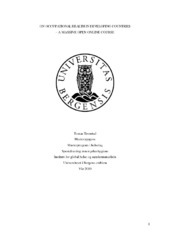On Occupational Health in Developing Countries – a Massive Open Online Course
Master thesis
Permanent lenke
https://hdl.handle.net/1956/20919Utgivelsesdato
2019-10-11Metadata
Vis full innførselSamlinger
Sammendrag
Introduction: Occupational injuries and diseases are estimated to cause more than 2.78 million fatalities annually, of which most occur in low- or middle-income countries (LMICs). In addition, a tremendous amount of non-fatal occupational injuries and illnesses occur worldwide each day. Knowledge of occupational safety and health is often absent or insufficient in many LMIC settings. Education is an integral part of the development of occupational safety and health systems in LMICs. The use of online resources like e.g. Massive Open Online Courses (MOOCs) is one way of reaching many, where the resources are sparse. In 2015, the University in Bergen launched the MOOC Occupational Health in Developing Countries. The course was explicitly aimed at sharing knowledge and experience of occupational safety and health with learners based in LMICs. Objective: The objective of the study is to describe the participant profiles and the participation activities of Occupational Health in Developing Countries learners. Method: The study is based on a quantitative review of data provided by the FutureLearn MOOC platform. The research design is descriptive and analytic. The introduction and contextualization are based on a review of relevant literature. Results: Out of totally 5866 registrants, 72.4 % attended from a LMIC geo-location, and 71.9 % of the 768 course completers were LMIC residents. Most of the participants were young, well-educated and employed; mostly within the health and social sector. The gender distribution was almost equal, except from a higher female non-completer proportion, especially among LMIC participants. The response rates were, however, relatively low. Conclusion: The MOOC succeeded in reaching its LMIC target group.
